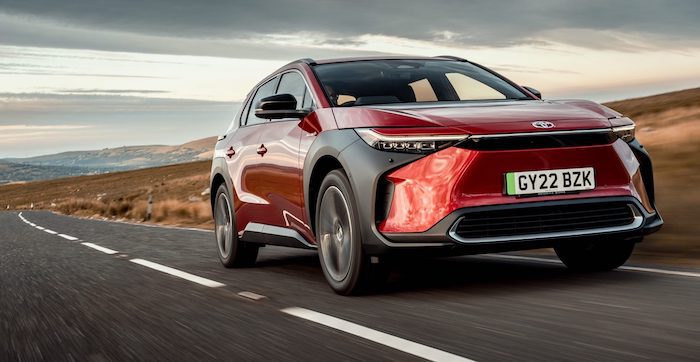The bZ4X is Toyota’s first full electric vehicle offering, which may come as something of a surprise from the world’s biggest car company, coming at least five years behind much of the rest of the car industry, despite Toyota being among the pioneers of hybrid technology. Better late than never? This introduction heralds the beginning of Toyota’s ambitious roadmap to unveil 15 EV models by 2025, with stories of a new type of a revolutionary solid-state battery coming from the Japanese giant and Panasonic by 2027.
The SUV flaunts an arresting and angular design language, which the company says is “where high-tech innovation meets emotional resonance.” Its distinctive “hammerhead” front styling will become a signature design for the forthcoming Toyota EVs. The bZ4X aims to convey a sense of a lower centre of gravity, a hallmark of electric vehicles.
However, in contrast to Toyota’s iconic model names like Corolla or Land Cruiser, ‘bZ4X’ feels less memorable and doesn’t exactly roll off your tongue, but Toyota explains that the bZ refers to “Beyond Zero” while 4 is taken from RAV4, as this is seen as the electric equivalent of that car. The X simply indicates that this is a “Crossover”. I still don’t understand why the “b” is lower case though.
In terms of size, this crossover aligns closely with the RAV4 in terms of width and height, but it boasts a longer wheelbase, resulting in generous interior space. The same car is also available as the Subaru Solterra, as the new car is a joint venture between the two, with Subaru being responsible for developing the all-wheel-drive system to ensure genuine off-road capabilities—an rare trait for a fully electric vehicle.
Meanwhile Toyota teamed up with Panasonic to create a 71.4-kilowatt-hour battery pack featuring 96 water-cooled cells. The battery’s longevity is commendable, offering a guarantee to retain 70% of its capacity for up to 10 years or 1 million kilometres. The front-wheel-drive version of the bZ4X offers a range of 318 miles and the all-wheel-drive variant delivers 286 miles. A 44-minute charge saw the battery go from 30% to 88%, resulting in a range of 205 miles at a cost of approximately £28.
The front-wheel-drive BZ4X packs a punch with 201 brake horsepower and 266Nm, enabling it to reach 62mph in approximately 7.5 seconds. In contrast, the all-wheel-drive version shines with two motors—one for each axle—generating a total of 215 brake horsepower and 337Nm of torque, propelling it to 62mph in a swift 6.9 seconds. Both variants comfortably cruise at 100 mph.
Inside the Toyota bZ4X, an expansive and comfortable cabin awaits, ideally suited for family journeys. The extended wheelbase translates to ample knee room for rear passengers, although the foot area may feel slightly snug. Nonetheless, headroom remains generous, and the synthetic leather upholstery, coupled with heated and cooled front seats, adds a touch of opulence. Rear passengers are treated to two USB-C chargers, individual vents, and a panoramic glass roof with a partition. The rear cargo area offers 452 litres of storage space, rendering it highly practical for daily use.
The infotainment system boasts a user-friendly 12.3-inch display equipped with seamless controls and an array of connectivity options. Unique to this model is the unconventional positioning of the steering wheel, situated lower than the instrument panel, which may require some adaptation. However, this layout contributes to reduced eye strain because the display is placed further back, and somewhat surprisingly doesn’t suffer from reflections and glare. The cabin thoughtfully incorporates ample storage solutions, including a cleverly designed storage box, wireless phone charging, and various charging ports. Although the absence of a glove box does surprise.
Behind the wheel, the BZ4X delivers an enjoyable driving experience. The steering is light and the car highly manoeuvrable, making it exceptionally well-suited for urban environments. Visibility is generally good, although the substantial A-pillars may obstruct certain views, a limitation mitigated by the inclusion of a 360-degree camera system. The camera even features an underbody view when reversing or in off-road mode, so you can actually see what’s beneath the car.
The ride quality is superb, adeptly handling diverse road surfaces and ensuring comfort. Regenerative braking facilitates one-pedal driving, simplifying city commutes. Performance is more than adequate, although it’s delivered in a measured rather than brutal manner as some EVs are wont to do.
Straight out of the box, Toyota is demonstrating its mastery of car making but now with an EV drivetrain. Its blend of practicality, spacious interior, remarkable range, and Toyota’s renowned reputation for reliability positions it as a formidable contender in the EV market. If there is a concern, as ever with electric vehicles, it pertains to the price which in this case goes from a hefty £46k to well over an eye-watering £54k. By comparison a RAV4 is £38k-44k.
BrownCarGuy.com
YouTube.com/BrownCarGuy
Facebook.com/BrownCarGuy
Instagram.com/ShahzadSheikh
Twitter.com/Shahzad_Sheikh











